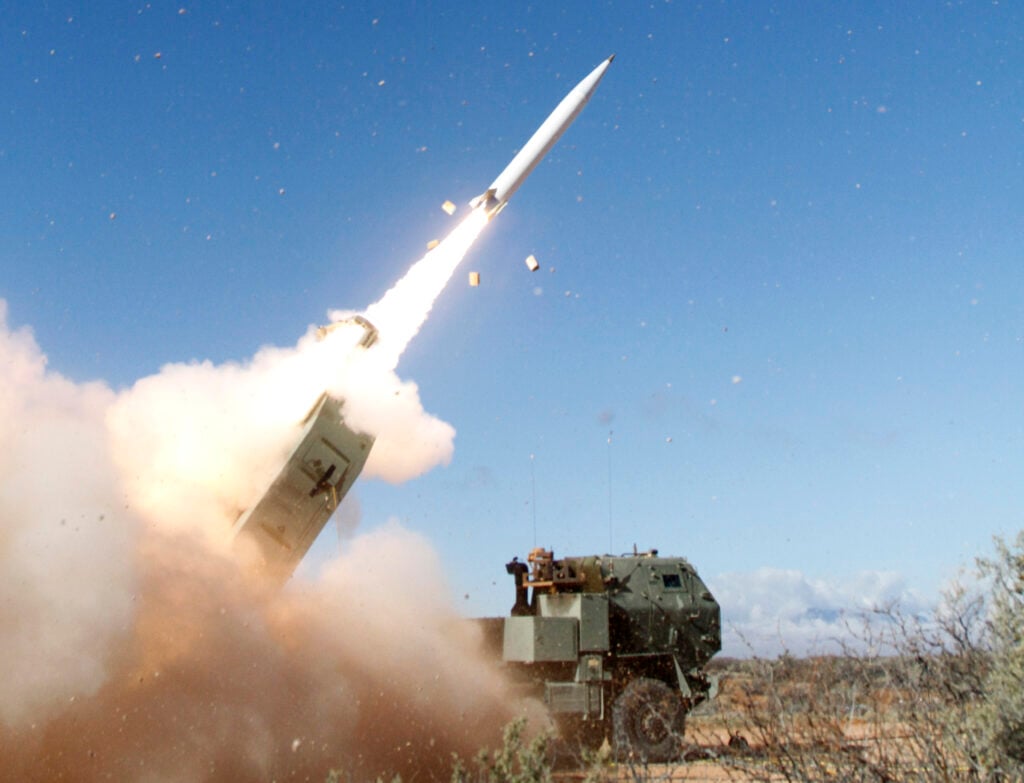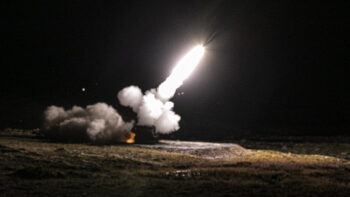
Lockheed’s prototype Precision Strike Missile (PrSM) fires from an Army HIMARS launcher truck. (US Army)
OPINION: Driven by alarming increases in long range missile and strike technologies possessed by potential adversaries, the US military is pursuing an unprecedented array of capabilities for Long Range Precision Fires (LRPF) as a vital readiness requirement for Great Power Competition.
The US often seeks solutions for firepower primarily in the arena of new long-range weaponry. Yet, experience shows that emphasis on weapons technology alone is a serious mistake.
Instead, DoD and industry should focus primarily on the creation of the elaborate enterprise of high-technologies, networks, sensors, and related Electromagnetic Spectrum (EMS) activities required to ensure US strike capabilities are strategically effective and accurate at unprecedented distances. And to handle the enormous amounts of data this enterprise generates, it must come hand in hand with robust Artificial Intelligence (AI) to achieve everything from speed-of-decision to reliable target identification and precision tracking. All are crucial if we are to understand targets and environments well enough for any long-range strike to be both effective and still meet US legal and ethical standards.
Employment of these EMS capabilities will be more technically and operationally complex than the strike itself. And, because all pre-strike preparations are completely dependent on various forms of electronic/digital data consumption, analysis, and transmission, these activities and their networks must also be defended against increasingly sophisticated adversary penetration, jamming, spoofing, obfuscation, and/or other forms of physical or digital interference.
Therefore, the US must put even greater emphasis on obtaining abilities for new and more powerful data processing, as well as the effective integration of these technologies to ensure future US strikes are operationally and strategically successful.
Elements of existing strategies, such as the 2018 National Defense Strategy and the more recent Electromagnetic Spectrum Superiority Strategy, can be useful guides for this purpose, but time is not on our side since our adversaries are doing likewise.
Here is an offering of some specifics worth much stronger pursuit:
- Greater focus on integrating existing and future sensor networks: As the US seeks to improve maritime, terrestrial, air-breathing, and space-based sensor arrays, an equal amount of resources and effort must be devoted to ensuring effective integration among and between them. While creating exquisite sensors is important, sensor networks need to be effectively integrated to achieve both understanding and insights that are unavailable if these sensor arrays operate in “silos.”
- Faster deployment of Artificial Intelligence: Only AI can alleviate the crushing cognitive overload challenge that enormous volumes of data will create for operators and analysts everywhere, a rapid development of deployable Artificial Intelligence capabilities is needed, in conjunction with equally strong emphasis on ease-of-use software and interfaces (e.g. graphic user interfaces).
- Risk Tolerance: Government and industry must find ways to innovate new technology and capabilities in ways that will challenge existing government practices, and even legal boundaries. This includes the challenge of ensuring the government workforce is effectively trained and educated to expertly handle technologies that will iterate and change with unprecedented speed.
It is instructive to recall a history lesson that began 20 years ago that is directly applicable to today’s Long Range Precision Fires challenge.
After the events of 9/11, one of the US military’s highest strategic priorities was to target and strike terrorist elements in several regions of the world. However, military leaders and commanders, like myself, were quickly forced to realize that our biggest challenge wasn’t that we lacked sufficient strike capabilities – the weapons and delivery platforms.
Instead, our principal weakness was a pervasive inability to identify, find, track, and fix a target in time-and-space sufficiently to justify a kinetic strike. We needed to be precise enough to destroy or neutralize a terrorist target and still avoid collateral damage. Many commanders were reporting that their biggest challenge was not “taking action” against a terrorist target, but instead was their inability to “identify and target” that adversary in ways that made kinetic action a viable and ethical option. These requirements have not fundamentally changed in an era where we must emphasize readiness for Great Power Competition.
Ultimately this need drove what I still consider to be the best example of a “revolution in military affairs” in my own career. This was the adoption of what we today call the “find, fix, finish, exploit, and analyze” formula, or F3EA as it is commonly described. Note that only one of those five words is about kinetic action. Put another way, we came to recognize that the only way to create the “finish” activities we prized was to invest far more in such intelligence, targeting, exploitation, and dissemination capabilities. And in today’s digital age, almost all of these activities are “digital and computerized” in nature, and occur within, or are strongly connected to, the Electromagnetic Spectrum.
Today, as our need for greater readiness against an armed conflict with a “near peer adversary” that has access to unprecedented long range fires of their own, both policymakers and practitioners would be wise to apply these lessons from our counterterrorism experiences.
The most challenging, and therefore the most important, aspect of attaining our own ambitions for unprecedented Long Range Precision Fires will probably not be the creation of the strike platforms and weapons themselves, as advanced as they may be. The challenge is in the support structure — and the sooner leaders recognize this truth, the safer America will be.
Lt. Gen. (Ret.) Michael K. Nagata is a Strategic Advisor for CACI International, and is a Distinguished Senior Fellow for the Middle East Institute. His military career spanned 38 years of active Army service; including 34 years serving in US Special Operations Forces. His final government position was Director of Strategic Operational Planning for the U.S. National Counterterrorism Center from 2016 to 2019.






















